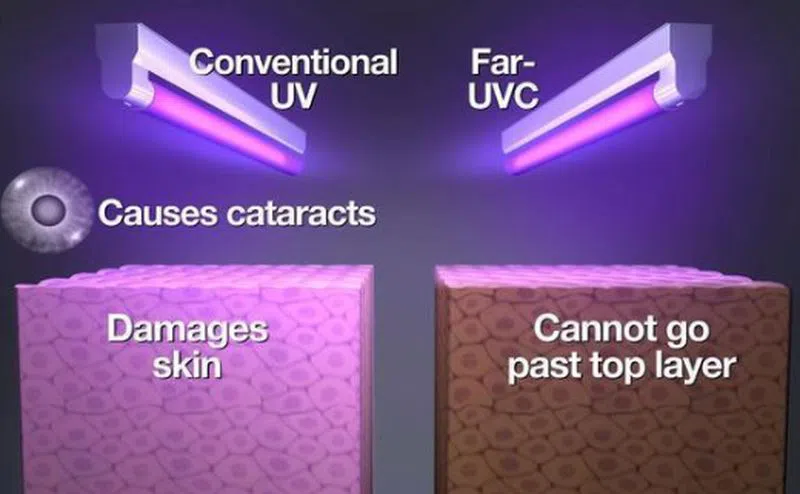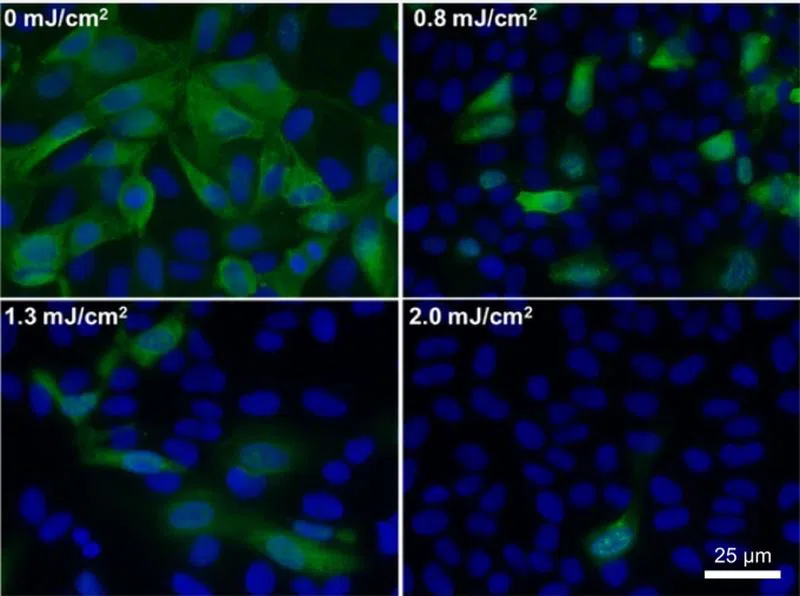English 



A
General Data
1 Input voltage AC100~AC250v
2 Lamp Power Consumption 20W
3Lamp Current 1.2A
B UVC Output 3500μW/cm2 (0CM)
UVC Wavelength 222nm
C Starting and Operation Features
1 Max. Starting time 25℃: 3 seconds
2 Time to reach 90% UV Output: 3 seconds
3 Ambient Temperature Range: Max:50℃,Min:-30℃
D Lifetime 4000 Hours
Switching cycles(3sOn/15sOff) >500000
E Safety Requirement Mercury-free
Max. Tempature 100℃
F Dimensions
Lamp size 360*130*45mm (L*W*H)
G
Glass Tube High Purity Quartz
H
Storage Enviroment Dry,and Ventilation Enviroment
Temperture of storage places: Max:60℃ Min:-25℃



The far UVClamp can be safely used in unoccupied and occupied spaces without posing a health risk to humans when used within the current exposure .
What appears to be certain now, is that Far UVc 222 nm does not cause cancer or cataracts in mice in a least one long term clinical study. Kobe University just came out with a key study on Far UVc effects that could be ground breaking in combating the COVID19 pandemic. They tested a relatively obscure UV wavelength of far UVC 222nm in October 2013 by Columbia University Center for Radiological Research (CRR) team. Brenner et al showed the promise of limiting the spread of coronavirus, as well as more familiar viruses like influenza and measles with Far UVc light.


See below test , it can reach 50μW/cm2 from distance 100cm so can be widely used in public such as bus station, train station , hospital...

Different UVC lamp irradiation has different disinfection effect as below it depends on the UVC 222nm irradiation dose, very low doses of far-UVC light efficiently kill airborne human coronaviruses carried by aerosols. A dose as low as 1.2 to 1.7 mJ/cm2 of 222-nm light inactivates 99.9% of the airborne human coronavirus tested from both genera beta and alpha, respectively. As all human coronaviruses have similar genomic size, a key determinant of radiation sensitivity, it is likely that far-UVC light will show comparable inactivation efficiency against other human coronaviruses, including SARS-CoV-2.

A
General Data
1 Input voltage AC100~AC250v
2 Lamp Power Consumption 20W
3Lamp Current 1.2A
B UVC Output 3500μW/cm2 (0CM)
UVC Wavelength 222nm
C Starting and Operation Features
1 Max. Starting time 25℃: 3 seconds
2 Time to reach 90% UV Output: 3 seconds
3 Ambient Temperature Range: Max:50℃,Min:-30℃
D Lifetime 4000 Hours
Switching cycles(3sOn/15sOff) >500000
E Safety Requirement Mercury-free
Max. Tempature 100℃
F Dimensions
Lamp size 360*130*45mm (L*W*H)
G
Glass Tube High Purity Quartz
H
Storage Enviroment Dry,and Ventilation Enviroment
Temperture of storage places: Max:60℃ Min:-25℃



The far UVClamp can be safely used in unoccupied and occupied spaces without posing a health risk to humans when used within the current exposure .
What appears to be certain now, is that Far UVc 222 nm does not cause cancer or cataracts in mice in a least one long term clinical study. Kobe University just came out with a key study on Far UVc effects that could be ground breaking in combating the COVID19 pandemic. They tested a relatively obscure UV wavelength of far UVC 222nm in October 2013 by Columbia University Center for Radiological Research (CRR) team. Brenner et al showed the promise of limiting the spread of coronavirus, as well as more familiar viruses like influenza and measles with Far UVc light.


See below test , it can reach 50μW/cm2 from distance 100cm so can be widely used in public such as bus station, train station , hospital...

Different UVC lamp irradiation has different disinfection effect as below it depends on the UVC 222nm irradiation dose, very low doses of far-UVC light efficiently kill airborne human coronaviruses carried by aerosols. A dose as low as 1.2 to 1.7 mJ/cm2 of 222-nm light inactivates 99.9% of the airborne human coronavirus tested from both genera beta and alpha, respectively. As all human coronaviruses have similar genomic size, a key determinant of radiation sensitivity, it is likely that far-UVC light will show comparable inactivation efficiency against other human coronaviruses, including SARS-CoV-2.

